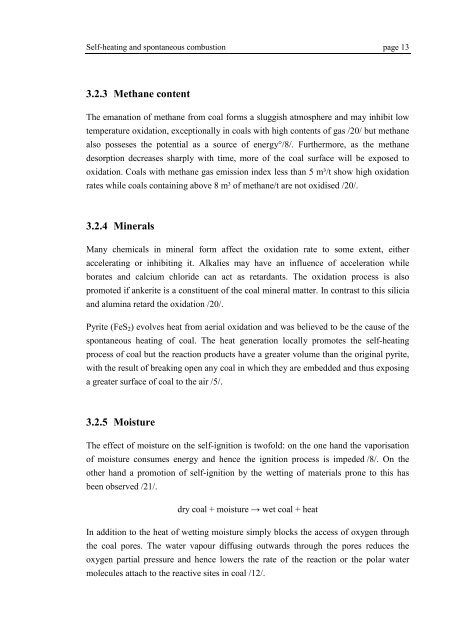Understanding self-ignition of coal - Sino German Coal fire project
Understanding self-ignition of coal - Sino German Coal fire project
Understanding self-ignition of coal - Sino German Coal fire project
Create successful ePaper yourself
Turn your PDF publications into a flip-book with our unique Google optimized e-Paper software.
Self-heating and spontaneous combustion page 13<br />
3.2.3 Methane content<br />
The emanation <strong>of</strong> methane from <strong>coal</strong> forms a sluggish atmosphere and may inhibit low<br />
temperature oxidation, exceptionally in <strong>coal</strong>s with high contents <strong>of</strong> gas /20/ but methane<br />
also posseses the potential as a source <strong>of</strong> energy°/8/. Furthermore, as the methane<br />
desorption decreases sharply with time, more <strong>of</strong> the <strong>coal</strong> surface will be exposed to<br />
oxidation. <strong>Coal</strong>s with methane gas emission index less than 5 m³/t show high oxidation<br />
rates while <strong>coal</strong>s containing above 8 m³ <strong>of</strong> methane/t are not oxidised /20/.<br />
3.2.4 Minerals<br />
Many chemicals in mineral form affect the oxidation rate to some extent, either<br />
accelerating or inhibiting it. Alkalies may have an influence <strong>of</strong> acceleration while<br />
borates and calcium chloride can act as retardants. The oxidation process is also<br />
promoted if ankerite is a constituent <strong>of</strong> the <strong>coal</strong> mineral matter. In contrast to this silicia<br />
and alumina retard the oxidation /20/.<br />
Pyrite (FeS2) evolves heat from aerial oxidation and was believed to be the cause <strong>of</strong> the<br />
spontaneous heating <strong>of</strong> <strong>coal</strong>. The heat generation locally promotes the <strong>self</strong>-heating<br />
process <strong>of</strong> <strong>coal</strong> but the reaction products have a greater volume than the original pyrite,<br />
with the result <strong>of</strong> breaking open any <strong>coal</strong> in which they are embedded and thus exposing<br />
a greater surface <strong>of</strong> <strong>coal</strong> to the air /5/.<br />
3.2.5 Moisture<br />
The effect <strong>of</strong> moisture on the <strong>self</strong>-<strong>ignition</strong> is tw<strong>of</strong>old: on the one hand the vaporisation<br />
<strong>of</strong> moisture consumes energy and hence the <strong>ignition</strong> process is impeded /8/. On the<br />
other hand a promotion <strong>of</strong> <strong>self</strong>-<strong>ignition</strong> by the wetting <strong>of</strong> materials prone to this has<br />
been observed /21/.<br />
dry <strong>coal</strong> + moisture → wet <strong>coal</strong> + heat<br />
In addition to the heat <strong>of</strong> wetting moisture simply blocks the access <strong>of</strong> oxygen through<br />
the <strong>coal</strong> pores. The water vapour diffusing outwards through the pores reduces the<br />
oxygen partial pressure and hence lowers the rate <strong>of</strong> the reaction or the polar water<br />
molecules attach to the reactive sites in <strong>coal</strong> /12/.


